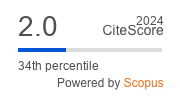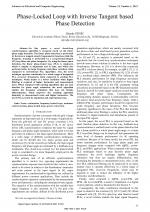| 1/2021 - 4 |
Phase-Locked Loop with Inverse Tangent based Phase DetectionSTOJIC, D. |
| Extra paper information in |
| Click to see author's profile in |
| Download PDF |
Author keywords
estimation, frequency locked loops, nonlinear control systems, phase locked loops, power conversion
References keywords
power(23), electronics(20), phase(17), grid(15), synchronization(14), systems(12), industrial(11), loop(7), locked(5), energy(5)
Blue keywords are present in both the references section and the paper title.
About this article
Date of Publication: 2021-02-28
Volume 21, Issue 1, Year 2021, On page(s): 37 - 44
ISSN: 1582-7445, e-ISSN: 1844-7600
Digital Object Identifier: 10.4316/AECE.2021.01004
Web of Science Accession Number: 000624018800004
SCOPUS ID: 85106415974
Abstract
In this paper, a novel closed-loop synchronization algorithm is proposed based on the linear phase angle detection. The linear phase detection is performed by the inverse tangent (atan2) trigonometric function, while the frequency tracking is performed by a proportional-integral (PI) loop filter and phase integrator. By using the linear phase detection, the linear phase-locked loop (PLL) is employed, which is simpler to implement and to tune, and which also performs better for large frequency and phase variations when compared to conventional PLL algorithms. Also, the novel technique operates consistently for a whole range of designated PLL crossover frequencies when compared to existing PLL techniques, which makes it a better candidate when higher filtering is required of higher harmonics and measurement noise. When compared with existing algorithms that use atan function for phase angle estimation, the novel algorithm enables the frequency estimation that does not include differentiation, which improves the resulting algorithm immunity to measurement noise and higher harmonics. The novel PLL is tested by simulation and experimental runs. |
| References | | | Cited By «-- Click to see who has cited this paper |
| [1] S. Golestan, M. Monfared, F. D. Freijedo, J.M. Guerrero, "Dynamics assessment of advanced single-phase PLL structures," IEEE Transactions on industrial electronics, vol. 60, no. 6, pp. 2167-2177, 2013. [CrossRef] [SCOPUS Times Cited 352] [2] R. M. Santos Filho, P. F. Seixas, P. C. Cortizo, L. A. Torres, and A. F. Souza, "Comparison of three single-phase PLL algorithms for UPS applications," IEEE Transactions on industrial electronics, vo. 55, no. 8, pp. 2923-2932, 2008. [CrossRef] [SCOPUS Times Cited 442] [3] F. Baradarani, M. R. D. Zadeh, M. A. Zamani, "A Phase-angle estimation method for synchronization of grid-connected power-electronic converters," IEEE Transactions on Power Delivery, vol. 30, no. 2, pp. 827-835, 2015. [CrossRef] [SCOPUS Times Cited 46] [4] M. Karimi-Ghartemani, and M. R. Iravani, "A Method for synchronization of power electronic converters in polluted and variable-frequency environments," IEEE Transactions on Power Systems, vol. 19, no. 3, pp. 1263-1270, 2004. [CrossRef] [SCOPUS Times Cited 591] [5] W. Li, X. Ruan, C. Bao, D. Pan, X. Wang, "Grid synchronization systems of three-phase grid-connected power converters: A complex-vector-filter perspective,"IEEE Transactions on industrial electronics, vol. 61, no. 4, pp. 1855-1870, 2014. [CrossRef] [SCOPUS Times Cited 212] [6] Y. Han, M. Luo, X. Zhao, J. M. Guerrero, L. Xu, "Comparative performance evaluation of orthogonal-signal-generators-based single-phase PLL algorithms-a survey," IEEE Transactions on Power Electronics, vol. 31, no. 5, pp. 3932-3944, 2016. [CrossRef] [SCOPUS Times Cited 349] [7] A. Luna, J. Rocabert, J. I. Candela, J. R. Hermoso, R. Teodorescu, F. Blaabjerg P. Rodriguez, "Grid voltage synchronization for distributed generation systems under grid fault conditions," IEEE Transactions on Industry Applications, vol. 51, no. 4, pp. 3414-3425, 2015. [CrossRef] [SCOPUS Times Cited 191] [8] A. Timbus, M. Liserre, R. Teodorescu, F. Blaabjerg, "Synchronization Methods for Three Phase Distributed Power Generation Systems-an Overview and Evaluation," in Power Electronics Specialists Conference, PESC'05. IEEE 36th, 2005. [CrossRef] [SCOPUS Times Cited 318] [9] F. Blaabjerg, R. Teodorescu, M. Liserre, A. V. Timbus, "Overview of control and grid synchronization for distributed power generation systems," IEEE Transactions on industrial electronics, vol. 53, no. 5, pp. 1398-1409, 2006. [CrossRef] [SCOPUS Times Cited 4799] [10] M. Comanescu, L. Xu, "An improved flux observer based on PLL frequency estimator for sensorless vector control of induction motors," Industrial Electronics, IEEE Transactions on, vol. 53, no. 1, pp. 50-56, 2006. [CrossRef] [SCOPUS Times Cited 175] [11] V. Kaura, V. Blasko, "Operation of a phase locked loop system under distorted utility conditions," IEEE Transactions on Industry Applications, vol. 33, no. 1, pp. 58-63, 1997. [CrossRef] [SCOPUS Times Cited 1033] [12] P. Rodriguez, A. Luna, M. Ciobotaru, R. Teodorescu, F. Blaabjerg, "Advanced grid synchronization system for power converters under unbalanced and distorted operating conditions," IEEE Industrial Electronics, IECON 2006-32nd Annual Conference on, 2006. [CrossRef] [SCOPUS Times Cited 456] [13] A. V. Timbus, R. Teodorescu, F. Blaabjerg, M. Liserre, P. Rodriguez, "PLL algorithm for power generation systems robust to grid voltage faults," in Proc. of PESC, 2006. [CrossRef] [SCOPUS Times Cited 79] [14] L. Liu, H. Li, Z. Wu, Y. Zhou, "A cascaded photovoltaic system integrating segmented energy storages with self-regulating power allocation control and wide range reactive power compensation," IEEE Transactions on Power Electronics, vol. 26, no. 12, pp. 3545-3559, 2011. [CrossRef] [SCOPUS Times Cited 91] [15] M. Padua, S. Deckmann, G. Sperandio, F. Marafao, D. Colon, "Comparative analysis of synchronization algorithms based on PLL, RDFT and Kalman filter," in Industrial Electronics, 2007. ISIE 2007. IEEE International Symposium on, 2007. [CrossRef] [SCOPUS Times Cited 53] [16] G. H. Jung, G. C. Cho, S. W. Hong, G. H. Cho, "Dsp based control of high power static VAr compensator using novel vector product phase locked loop," in Power Electronics Specialists Conference, 1996. PESC'96 Record., 27th Annual IEEE, 1996. [CrossRef] [17] L. Zheng, H. Geng, G. Yang, "Fast and robust phase estimation algorithm for heavily distorted grid conditions," IEEE Transactions on industrial electronics, vol. 63, no. 11, pp. 6845-6855, 2016. [CrossRef] [SCOPUS Times Cited 79] [18] S. Golestan, M. Ramezani, J. M. Guerrero, F. D. Freijedo, M. Monfared, "Moving average filter based phase-locked loops: Performance analysis and design guidelines," IEEE Transactions on Power Electronics, vol. 29, no. 6, pp. 2750-2763, 2014. [CrossRef] [SCOPUS Times Cited 527] [19] S. Chandrasekaran, K. Ragavan, "Adaptive sampling period adjusted sliding DFT for synchronous reference frame PLL," in Power Electronics, Drives and Energy Systems (PEDES), 2014 IEEE International Conference on, 2014. [CrossRef] [SCOPUS Times Cited 11] [20] F. Cupertino, E. Lavopa, P. Zanchetta, M. Sumner, L. Salvatore, "Running DFT-based PLL algorithm for frequency, phase, and amplitude tracking in aircraft electrical systems," IEEE Transactions on industrial electronics, vol. 58, no. 3, pp. 1027-1035, 2011. [CrossRef] [SCOPUS Times Cited 103] [21] N. Guerrero-RodrÃguez, A. B. Rey-Boue, E. Bueno, O. Ortiz, E. Reyes-Archundia, "Synchronization algorithms for grid-connected renewable systems: Overview, tests and comparative analysis," Renewable and Sustainable Energy Reviews, 2016. [CrossRef] [SCOPUS Times Cited 30] [22] Y. F. Wang, Y. W. Li, "Grid synchronization PLL based on cascaded delayed signal cancellation," IEEE Transactions on Power Electronics, vol. 26, no. 7, pp. 1987-1997, 2011. [CrossRef] [SCOPUS Times Cited 302] [23] S. Golestan, J. M. Guerrero, J. C. Vasquez, "Three-phase PLLs: a review of recent advances," IEEE Transactions on Power Electronics, vol. 32, no. 3, pp. 1894-1907, 2017. [CrossRef] [SCOPUS Times Cited 703] [24] R. Teodorescu, M. Liserre, P. Rodriguez, "Grid converters for photovoltaic and wind power systems," John Wiley & Sons, 2011. [CrossRef] [25] S. Golestan, A. Vidal, A. G. Yepes, J. M. Guerrero, J. C. Vasquez, J. Doval-Gandoy, "A true open-loop synchronization technique," IEEE Transactions on Industrial Informatics, vol. 12, no. 3, pp. 1093-1103, 2016. [CrossRef] [SCOPUS Times Cited 52] [26] F. Xiao, L. Dong, L. Li, X. Liao, "A novel open-loop frequency estimation method for single-phase grid synchronization under distorted conditions," IEEE Journal of Emerging and Selected Topics in Power Electronics, vol. 5, no. 3, pp. 1287-1297, 2017. [CrossRef] [SCOPUS Times Cited 33] [27] A. K. Verma, R. K. Jarial, P. Roncero-Sanchez, M. R. Ungarala, J. M. Guerrero, "An improved hybrid pre-filtered open-loop algorithm for three-phase grid synchronization," IEEE Transactions on Industrial Electronics 2020. [CrossRef] [SCOPUS Times Cited 44] [28] Z. Ali, N. Christofides, L. Hadjidemetriou, E. Kyriakides, Y. Yang, F. Blaabjerg, "Three-phase phase-locked loop synchronization algorithms for grid-connected renewable energy systems: A review," Renewable and Sustainable Energy Reviews, vol. 90, pp. 434-452, 2018. [CrossRef] [SCOPUS Times Cited 162] [29] S. Golestan, F. D. Freijedo, A. Vidal, J. M. Guerrero, J. Doval-Gandoy, "A quasi-type-1 phase-locked loop structure," IEEE Transactions on Power Electronics, vol. 29, no. 12, pp. 6264-6270, 2014. [CrossRef] [SCOPUS Times Cited 136] [30] S. Preitl, R.-E. Precup, "An extension of tuning relations after symmetrical optimum method for PI and PID controllers," Automatica, vol. 35, no. 10, pp. 1731-1736, Oct. 1999. [CrossRef] [SCOPUS Times Cited 223] [31] T. Haidegger, K. Levente, R.-E. Precup, S. Preitl, B. Benyo, Z. Benyo, "Cascade control for telerobotic systems serving space medicine," IFAC Proceedings, vol. 44, no. 1, 2011, pp. 3759-3764. [CrossRef] [SCOPUS Times Cited 107] Web of Science® Citations for all references: 0 SCOPUS® Citations for all references: 11,699 TCR Web of Science® Average Citations per reference: 0 SCOPUS® Average Citations per reference: 366 ACR TCR = Total Citations for References / ACR = Average Citations per Reference We introduced in 2010 - for the first time in scientific publishing, the term "References Weight", as a quantitative indication of the quality ... Read more Citations for references updated on 2025-07-01 01:04 in 205 seconds. Note1: Web of Science® is a registered trademark of Clarivate Analytics. Note2: SCOPUS® is a registered trademark of Elsevier B.V. Disclaimer: All queries to the respective databases were made by using the DOI record of every reference (where available). Due to technical problems beyond our control, the information is not always accurate. Please use the CrossRef link to visit the respective publisher site. |
Faculty of Electrical Engineering and Computer Science
Stefan cel Mare University of Suceava, Romania
All rights reserved: Advances in Electrical and Computer Engineering is a registered trademark of the Stefan cel Mare University of Suceava. No part of this publication may be reproduced, stored in a retrieval system, photocopied, recorded or archived, without the written permission from the Editor. When authors submit their papers for publication, they agree that the copyright for their article be transferred to the Faculty of Electrical Engineering and Computer Science, Stefan cel Mare University of Suceava, Romania, if and only if the articles are accepted for publication. The copyright covers the exclusive rights to reproduce and distribute the article, including reprints and translations.
Permission for other use: The copyright owner's consent does not extend to copying for general distribution, for promotion, for creating new works, or for resale. Specific written permission must be obtained from the Editor for such copying. Direct linking to files hosted on this website is strictly prohibited.
Disclaimer: Whilst every effort is made by the publishers and editorial board to see that no inaccurate or misleading data, opinions or statements appear in this journal, they wish to make it clear that all information and opinions formulated in the articles, as well as linguistic accuracy, are the sole responsibility of the author.



